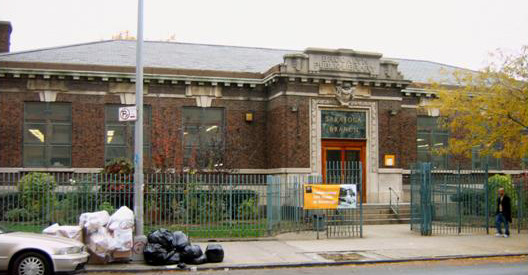BROOKLYN PUBLIC LIBRARY, SARATOGA BRANCH
8 Thomas S. Boyland St
Brooklyn, NY 11233
Block: 1498 Lot: 35
Lot Area: 3,547 sq ft (67.25’ x 52.75’)
Number of floors: 1
Building Area: 3,000 sq ft (estimated)
Year(s) built: 1908
Year opened: 1908
Architect(s): R.L. Daus (Daus & Otto)
Builder(s): William L. Crow Construction Company
Status: Library, no designation
DESCRIPTION:
Architectural Classification:
Late 19th & 20th Century Revivals
Classical Revival
Materials:
Foundation: Brick
Walls: Brick, Stone
Summary:
The Brooklyn Public Library was created through state legislation in 1892 and began functioning five years later. In 1901, Andrew Carnegie signed a contract guaranteeing the erection of new public libraries in Brooklyn. In November of that year, the Sites Committee posited the five areas in Brooklyn with the greatest need for Carnegie branches. The locations were Williamsburg, Fulton, Carroll Park, Bedford, and Stuyvesant (which included Bushwick).
The formerly private Brooklyn Library collection, in addition to several small independent libraries, formed the core of the Brooklyn Public Library by 1902. These independent facilities, including Brownsville, Bedford, Fort Hamilton, Washington Irving, and Flatbush, were soon housed in Carnegie buildings. Although the Brooklyn system was an independent corporation, the New York City mayor, comptroller and borough president were on the board of trustees ex-officio, and its staff was in the civil service. The Brooklyn Public Library’s main central building was not completed until 1941.
The New York City Carnegie branch libraries were designed to be distinct structures, a new concept at the turn of the Twentieth Century when most branches were simply located in other buildings. They were intended to be important fixtures in the community and centrally located in a neighborhood. The Carnegie Committee had a policy to locate branches in close proximity to public buildings such as schools, social service centers, public baths, or YM/YWCA’s. The Saratoga Branch has played this civic role in Ocean Hill for over a century.[i]
The building has several characteristics of the suburban Carnegie library type. Located mostly in the less densely populated areas of the Bronx, Brooklyn, Staten Island and Queens, these branches are most often freestanding structures within a larger lot (most often they are surrounded by a lawn). Frequently, the libraries feature brick walls accented with a minimum of limestone ornamentation. The buildings most often have a symmetrical layout, large windows to allow an abundance of light into the reading rooms, and a prominent, decorative entrance.
Narrative Description:
This one-story, seven-bay brick Classical Revival features projecting central entrance with large cartouche above and a pediment reading “BROOKLYN PUBLIC LIBRARY”. A stone base and stone trim including keystones over the windows and a dentilated cornice add ornament to the building. The branch underwent rehabilitation work in 1958-60, 1974 and 1990. A new door and transom recalling the the original have recently been installed. There is a later, second-story rear addition and a modern barrier free access ramp.
The branch’s interior features original details such as the ornate cast iron mezzanine railing with a fish scale pattern that matches the front door grill. The interior also has a plaster ceiling with simple cove molding, and a wood and glass vestibule screen.
Land from Condemnation (24,751.80) 1906. Cost of structure with equipment 48,034.91 (Prendergast, 147)
____________________________________________________________________
Photos:
http://hdc.org/hdc-across-nyc/brooklyn/brooklyn-carnegie-libraries/saratoga-branch/photos
____________________________________________________________________
•To read the full list of each Carnegie Library in Brooklyn click here
[i] “The Trustees are of the opinion that in establishing branch libraries it is of great importance to establish them, as far as possible, in conspicuous positions on well frequented streets. In some measure the same principles should be applied that would govern in the selection of a site for a retail store. The fact that a branch library is constantly before the eyes of the neighboring residents so that all are familiar with its location will undoubtedly tend to increase its usefulness.” George L. Rives, Secretary of The New York Public Library (1901). From the NYPL Executive Committee Minutes as quoted in Phyllis Dain, The New York Public Library (New York: New York Public Library, 1972), 237, in Mary B. Dierickx, The Architecture of Literacy: The Carnegie Libraries of New York City (New York: The Cooper Union for the Advancement of Science and Art and The New York City Department of General Services, 1996), 27.
